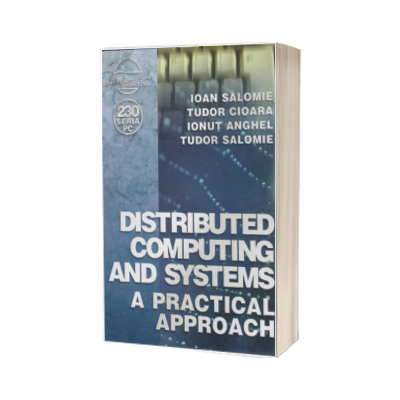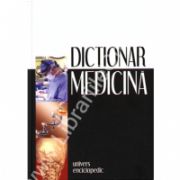Distributed computing and systems. A practical approach

PRP: 48,00 lei
?
Acesta este Prețul Recomandat de Producător. Prețul de vânzare al produsului este afișat mai jos.
Preț: 31,20 lei
Diferență: 16,80 lei
Disponibilitate: In stoc furnizor
Timp confirmare stoc: 1 - 2 zile lucratoare
Timp confirmare stoc: 1 - 2 zile lucratoare
Autor: Ioan Salomie
Editura: ALBASTRA
Anul publicării: 2008
Categoria: Limbaje de programare
DESCRIERE
This book aims at a practical approach of using the distributed computing paradigms and their supporting technologies for building distributed systems. A major part of the book is dedicated to the Internet as a programming model and context for distributed applications in the era of massive and global interconnectivity. The book presents the main distributed computing paradigms (distributed objects and remote method calls, component-based and message-based computing, service-oriented computing and business level workflows-based computing in SOA environments) along with fully functional examples, implemented in Java and. NET technologies.
1. BASICS OF PROGRAMMING WEB APPLICATIONS
1. 1. Fundamentals
1. 1. 1. Web Clients and Web Servers
1. 1. 2. An end-to-end scenario
1. 1. 3. The request-reply model
1. 1. 4. HyperText Transfer Protocol (HTTP)
1. 1. 4. 1. HTTP Methods
1. 1. 4. 2. HTTP Status Codes
1. 1. 4. 3. HTTP as a stateless protocol
1. 1. 5. Rendering simple Web Pages
1. 1. 6. Programming on the Client and Server side
1. 2. Technologies for Web Application Development
1. 2. 1. Client side programming technologies
1. 2. 1. 1. Java Applets
1. 2. 1. 2. JavaScript
1. 2. 1. 3. Microsoft Silverlight applications
1. 2. 2. Server side programming technologies
1. 2. 2. 1. JavaServlets
1. 2. 2. 2. JavaServer Pages (JSP)
1. 2. 2. 3. JavaServer Faces (JSF)
1. 2. 2. 4. Microsoft ASP. NET 2. 0 Web Applications
1. 2. 3. Data access and manipulation technologies
1. 2. 3. 1. Relational Data Servers
1. 2. 3. 2. XML Data and XML Schemas
1. 2. 3. 3. XML Data processing techniques
1. 2. 3. 4. Processing Relational Data in Java
1. 2. 3. 5. Processing Relational Data in. NET
1. 2. 3. 6. Processing XML Data Sources from Java
1. 2. 3. 7. Processing XML Data Sources from Microsoft. NET
1. 3. Solving problems using Web applications and technologies
1. 3. 1. Processing XML Data Sources in. NET using XmlReder. A weather forecast application
1. 3. 2. Processing XML Data Sources in Microsoft. NET using XmlDocument. A weather forecast application
1. 3. 3. Processing XML Data Sources in Microsoft. NET by using Data binding
1. 3. 4. Processing XML Data Sources in Java using SAX
1. 3. 5. Processing XML Data Sources in Java using JDOM
1. 3. 6. Working with Relational Data in. NET using DataReader
1. 3. 7. Working with Relational Data in. NET using DataSet
1. 3. 8. Working with Relational Data in Java using JDBC
1. 3. 9. A simple Java Servlet that generates HTML output
1. 3. 10. A simple Java Servlet that generates XML output
1. 3. 11. JavaServer Pages examples
1. 3. 12. Using JavaServer Pages for gathering HTML Forms POST Data in Java Beans
1. 3. 13. Using JavaServer Faces framework. The Hangman Game
1. 3. 14. Examples of Microsoft ASP. NET technology features
1. 3. 14. 1. Master Pages
1. 3. 14. 2. Web Site navigations controls
1. 3. 14. 3. Using the Session from ASP. NET
1. 3. 14. 4. Handling user generated events
1. 3. 14. 5. Data Binding
1. 3. 14. 6. Deploying and running the examples
1. 3. 15. Configuring the system for Java Enterprise Edition development
1. 3. 16. Configuring the system for. NET Framework 2. 0 development
1. 3. 17. Creating a Virtual Directory in IIS
1. 4. References
2. DISTRIBUTED OBJECTS
2. 1. Fundamentals
2. 1. 1. Local vs. Distributed Objects
2. 1. 1. 1. Life-cycle
2. 1. 1. 2. Activation / Deactivation and persistence
2. 1. 1. 3. References
2. 1. 1. 4. Latency
2. 1. 1. 5. Communications
2. 1. 1. 6. Security
2. 1. 2. Distributed Objects Middleware
2. 2. Java Remote Method Invocation
2. 2. 1. Java Local Objects vs. Remote Objects
2. 2. 2. Stubs and Skeletons
2. 2. 3. Threads and Garbage Collection in RMI
2. 2. 4. Dynamic code loading and parameter passing in RMI
2. 3. Microsoft. NET Remoting
2. 3. 1. Remote Objects
2. 3. 2. Proxy Objects
2. 3. 3. Message Transport (Channels)
2. 3. 4. Remote Object Activation
2. 3. 5. Configuring Remote Objects
2. 4. Solving Problems using Java RMI Data Access Middleware
2. 5. Using. NET Remoting to solve problems. A Simple Echoer Example
2. 5. 1. Single Call Activation solution
2. 5. 2. Singleton Activation
2. 5. 3. Client Activation
2. 6. Using. NET Remoting to solve problems. Data Access Middleware
2. 7. References
3. COMPONENT-BASED DISTRIBUTED SYSTEMS
3. 1. Fundamentals
3. 2. Enterprise Java Beans 3. 0
3. 2. 1. Session Beans
3. 2. 2. Message-Driven Beans
3. 2. 3. Java Persistence API and Entities
3. 2. 3. 1. Entities, primary keys and associations
3. 2. 3. 2. Managing Entities
3. 3. Microsoft COM and COM+
3. 3. 1. COM (Component Object Model)
3. 3. 2. COM+
3. 4. Using Components to Solve Problems The Apartment Booking System
3. 4. 1. Description
3. 4. 2. Analysis and Design
3. 4. 2. 1. Presentation Tier
3. 4. 2. 2. Business tier
3. 4. 2. 3. Data tier
3. 4. 3. Tools installation and configuration
3. 4. 4. Tools integration
3. 4. 4. 1. Sun Application Server and NetBeans IDE
3. 4. 4. 2. MySql, NetBeans IDE and Sun Application Server
3. 4. 5. Implementation
3. 4. 5. 1. Entity creation
3. 4. 5. 2. Session Bean creation
3. 4. 5. 3. Presentation layer- JSP implementation
3. 4. 6. Deployment and execution
3. 5. References
4. MESSAGE-BASED DISTRIBUTED SYSTEMS
4. 1. Fundamentals
4. 2. Java Message Services (JMS)
4. 2. 1. JMS Messaging Models
4. 2. 1. 1. JMS Publish-Subscribe Messaging
4. 2. 1. 2. JMS Point-To-Point Messaging
4. 2. 1. 3. Message Consumotion
4. 2. 2. JMS Architecture
4. 2. 2. 1. Connection Factory
4. 2. 2. 2. Destination
4. 2. 2. 3. Connections
4. 2. 2. 4. Sessions
4. 2. 2. 5. Messages
4. 2. 2. 6. Message producers
4. 2. 2. 7. Message consumers
4. 2. 2. 8. Queue browsers
4. 3. Microsoft Message Queuing (MSMQ)
4. 3. 1. MSMQ Architecture
4. 3. 2. Message Queue Management
4. 4. Using Messaging Systems to solve problems. The Apartment Booking System
4. 4. 1. Description
4. 4. 2. Analysis and Design
4. 4. 2. 1. Presentation tier
4. 4. 2. 2. Business tier
4. 4. 2. 3. Data tier
4. 4. 3. Resource installation and configuration
4. 4. 4. Implementation
4. 4. 4. 1. Entities
4. 4. 4. 2. The Session Beans
4. 4. 4. 3. Email Booking MDB
4. 4. 4. 4. Presentation Tier
4. 4. 5. Deployment and execution
4. 5. References
5. SERVICE ORIENTED ARCHITECTURES AND WEB SERVICES
5. 1. Fundamentals
5. 2. SOA Basic Resources
5. 2. 1. Simple Object Access Protocol (SOAP)
5. 2. 2. Web Service Description Language (WSDL)
5. 2. 3. Universal Description, Discovery, and Integration (UDDI)
5. 3. Web Services implementation technologies
5. 3. 1. NET Web Services
5. 3. 2. Java Web Services
5. 4. Using. NET Web Services to Solve Problems The Flight Booking System
5. 4. 1. Description
5. 4. 2. Analysis and Design
5. 4. 3. Tools installation and configuration
5. 4. 4. FlightBookingWS Web Service Implementation
5. 4. 5. FlightBookingWS Client Application
5. 4. 6. Deployment and execution
5. 5. Using JAX-WS to Solve Problems. The Hotel Booking System
5. 5. 1. Description
5. 5. 2. Analysis and Design
5. 5. 3. Tools installation and configuration
5. 5. 4. Java Web Service (HotelWS)
5. 5. 5. The Client Application
5. 5. 6. Deployment and execution
5. 6. References
6. BUSINESS PROCESSES AND WORKFLOWS
6. 1. Fundamentals
6. 1. 1. Business Processes
6. 1. 2. Workflows
6. 1. 3. Business processes and workflows
6. 2. BPEL4WS Language
6. 2. 1. The interaction between business processes and Web Services
6. 2. 2. The business process execution sequence
6. 3. Microsoft BizTalk Server
6. 4. Microsoft Windows Workflow Foundation (WF)
6. 5. Using Microsoft BizTalk Server to solve problems. The Holiday Package Booking System
6. 5. 1. Description
6. 5. 2. Analysis and Design
6. 5. 2. 1. The. NET Web Service design
6. 5. 2. 2. Java Web Service design
6. 5. 2. 3. Business process design
6. 5. 2. 4. Business process execution
6. 5. 3. Tools installation and configuration
6. 5. 3. 1. BizTalk Server 2006. The main software requirements for Windows 2003
6. 5. 3. 2. Essential notes for Microsoft BizTalk Server installation
6. 5. 3. 3. Step by step pre-installation requirements for Windows 2003
6. 5. 3. 4. Tools Configuration
6. 5. 3. 5. BizTalk Server 2006 installation steps
6. 5. 3. 6. Configuring BizTalk Server 2006
6. 5. 4. Business process development
6. 5. 4. 1. Web Services implementation
6. 5. 4. 2. Using BizTalk to create business process
6. 5. 4. 3. Linking partner services to the business process
6. 5. 4. 4. Business Process Logic Generation
6. 5. 4. 4. 1. Creating the flight booking business logic
6. 5. 4. 4. 2. Creating the hotel booking business logic
6. 5. 4. 4. 3. Creating the business process input structures
6. 5. 4. 4. 4. Creating the business process output structures
6. 5. 4. 5. Business Process building and deployment
6. 5. 4. 6. Business Process execution
6. 6. Using Microsoft Workflow Foundation to solve problems. The Weather Monitoring System
6. 6. 1. Description
6. 6. 2. Tools installation and configuration
6. 6. 3. Workflow design and implementation
6. 6. 3. 1. DisplayActivity
6. 6. 3. 2. WeatherActivity
6. 6. 3. 3. MailingActivity
6. 7. References
APPENDIX 1. The BPEL4WS file for the holiday booking business developed in Section 6. 5. 4.
Autori: I. Salomie, T. Cioara, I. Anghel, T. Salomie
Anul aparitiei: 2008
Nr. pagini: 367
1. BASICS OF PROGRAMMING WEB APPLICATIONS
1. 1. Fundamentals
1. 1. 1. Web Clients and Web Servers
1. 1. 2. An end-to-end scenario
1. 1. 3. The request-reply model
1. 1. 4. HyperText Transfer Protocol (HTTP)
1. 1. 4. 1. HTTP Methods
1. 1. 4. 2. HTTP Status Codes
1. 1. 4. 3. HTTP as a stateless protocol
1. 1. 5. Rendering simple Web Pages
1. 1. 6. Programming on the Client and Server side
1. 2. Technologies for Web Application Development
1. 2. 1. Client side programming technologies
1. 2. 1. 1. Java Applets
1. 2. 1. 2. JavaScript
1. 2. 1. 3. Microsoft Silverlight applications
1. 2. 2. Server side programming technologies
1. 2. 2. 1. JavaServlets
1. 2. 2. 2. JavaServer Pages (JSP)
1. 2. 2. 3. JavaServer Faces (JSF)
1. 2. 2. 4. Microsoft ASP. NET 2. 0 Web Applications
1. 2. 3. Data access and manipulation technologies
1. 2. 3. 1. Relational Data Servers
1. 2. 3. 2. XML Data and XML Schemas
1. 2. 3. 3. XML Data processing techniques
1. 2. 3. 4. Processing Relational Data in Java
1. 2. 3. 5. Processing Relational Data in. NET
1. 2. 3. 6. Processing XML Data Sources from Java
1. 2. 3. 7. Processing XML Data Sources from Microsoft. NET
1. 3. Solving problems using Web applications and technologies
1. 3. 1. Processing XML Data Sources in. NET using XmlReder. A weather forecast application
1. 3. 2. Processing XML Data Sources in Microsoft. NET using XmlDocument. A weather forecast application
1. 3. 3. Processing XML Data Sources in Microsoft. NET by using Data binding
1. 3. 4. Processing XML Data Sources in Java using SAX
1. 3. 5. Processing XML Data Sources in Java using JDOM
1. 3. 6. Working with Relational Data in. NET using DataReader
1. 3. 7. Working with Relational Data in. NET using DataSet
1. 3. 8. Working with Relational Data in Java using JDBC
1. 3. 9. A simple Java Servlet that generates HTML output
1. 3. 10. A simple Java Servlet that generates XML output
1. 3. 11. JavaServer Pages examples
1. 3. 12. Using JavaServer Pages for gathering HTML Forms POST Data in Java Beans
1. 3. 13. Using JavaServer Faces framework. The Hangman Game
1. 3. 14. Examples of Microsoft ASP. NET technology features
1. 3. 14. 1. Master Pages
1. 3. 14. 2. Web Site navigations controls
1. 3. 14. 3. Using the Session from ASP. NET
1. 3. 14. 4. Handling user generated events
1. 3. 14. 5. Data Binding
1. 3. 14. 6. Deploying and running the examples
1. 3. 15. Configuring the system for Java Enterprise Edition development
1. 3. 16. Configuring the system for. NET Framework 2. 0 development
1. 3. 17. Creating a Virtual Directory in IIS
1. 4. References
2. DISTRIBUTED OBJECTS
2. 1. Fundamentals
2. 1. 1. Local vs. Distributed Objects
2. 1. 1. 1. Life-cycle
2. 1. 1. 2. Activation / Deactivation and persistence
2. 1. 1. 3. References
2. 1. 1. 4. Latency
2. 1. 1. 5. Communications
2. 1. 1. 6. Security
2. 1. 2. Distributed Objects Middleware
2. 2. Java Remote Method Invocation
2. 2. 1. Java Local Objects vs. Remote Objects
2. 2. 2. Stubs and Skeletons
2. 2. 3. Threads and Garbage Collection in RMI
2. 2. 4. Dynamic code loading and parameter passing in RMI
2. 3. Microsoft. NET Remoting
2. 3. 1. Remote Objects
2. 3. 2. Proxy Objects
2. 3. 3. Message Transport (Channels)
2. 3. 4. Remote Object Activation
2. 3. 5. Configuring Remote Objects
2. 4. Solving Problems using Java RMI Data Access Middleware
2. 5. Using. NET Remoting to solve problems. A Simple Echoer Example
2. 5. 1. Single Call Activation solution
2. 5. 2. Singleton Activation
2. 5. 3. Client Activation
2. 6. Using. NET Remoting to solve problems. Data Access Middleware
2. 7. References
3. COMPONENT-BASED DISTRIBUTED SYSTEMS
3. 1. Fundamentals
3. 2. Enterprise Java Beans 3. 0
3. 2. 1. Session Beans
3. 2. 2. Message-Driven Beans
3. 2. 3. Java Persistence API and Entities
3. 2. 3. 1. Entities, primary keys and associations
3. 2. 3. 2. Managing Entities
3. 3. Microsoft COM and COM+
3. 3. 1. COM (Component Object Model)
3. 3. 2. COM+
3. 4. Using Components to Solve Problems The Apartment Booking System
3. 4. 1. Description
3. 4. 2. Analysis and Design
3. 4. 2. 1. Presentation Tier
3. 4. 2. 2. Business tier
3. 4. 2. 3. Data tier
3. 4. 3. Tools installation and configuration
3. 4. 4. Tools integration
3. 4. 4. 1. Sun Application Server and NetBeans IDE
3. 4. 4. 2. MySql, NetBeans IDE and Sun Application Server
3. 4. 5. Implementation
3. 4. 5. 1. Entity creation
3. 4. 5. 2. Session Bean creation
3. 4. 5. 3. Presentation layer- JSP implementation
3. 4. 6. Deployment and execution
3. 5. References
4. MESSAGE-BASED DISTRIBUTED SYSTEMS
4. 1. Fundamentals
4. 2. Java Message Services (JMS)
4. 2. 1. JMS Messaging Models
4. 2. 1. 1. JMS Publish-Subscribe Messaging
4. 2. 1. 2. JMS Point-To-Point Messaging
4. 2. 1. 3. Message Consumotion
4. 2. 2. JMS Architecture
4. 2. 2. 1. Connection Factory
4. 2. 2. 2. Destination
4. 2. 2. 3. Connections
4. 2. 2. 4. Sessions
4. 2. 2. 5. Messages
4. 2. 2. 6. Message producers
4. 2. 2. 7. Message consumers
4. 2. 2. 8. Queue browsers
4. 3. Microsoft Message Queuing (MSMQ)
4. 3. 1. MSMQ Architecture
4. 3. 2. Message Queue Management
4. 4. Using Messaging Systems to solve problems. The Apartment Booking System
4. 4. 1. Description
4. 4. 2. Analysis and Design
4. 4. 2. 1. Presentation tier
4. 4. 2. 2. Business tier
4. 4. 2. 3. Data tier
4. 4. 3. Resource installation and configuration
4. 4. 4. Implementation
4. 4. 4. 1. Entities
4. 4. 4. 2. The Session Beans
4. 4. 4. 3. Email Booking MDB
4. 4. 4. 4. Presentation Tier
4. 4. 5. Deployment and execution
4. 5. References
5. SERVICE ORIENTED ARCHITECTURES AND WEB SERVICES
5. 1. Fundamentals
5. 2. SOA Basic Resources
5. 2. 1. Simple Object Access Protocol (SOAP)
5. 2. 2. Web Service Description Language (WSDL)
5. 2. 3. Universal Description, Discovery, and Integration (UDDI)
5. 3. Web Services implementation technologies
5. 3. 1. NET Web Services
5. 3. 2. Java Web Services
5. 4. Using. NET Web Services to Solve Problems The Flight Booking System
5. 4. 1. Description
5. 4. 2. Analysis and Design
5. 4. 3. Tools installation and configuration
5. 4. 4. FlightBookingWS Web Service Implementation
5. 4. 5. FlightBookingWS Client Application
5. 4. 6. Deployment and execution
5. 5. Using JAX-WS to Solve Problems. The Hotel Booking System
5. 5. 1. Description
5. 5. 2. Analysis and Design
5. 5. 3. Tools installation and configuration
5. 5. 4. Java Web Service (HotelWS)
5. 5. 5. The Client Application
5. 5. 6. Deployment and execution
5. 6. References
6. BUSINESS PROCESSES AND WORKFLOWS
6. 1. Fundamentals
6. 1. 1. Business Processes
6. 1. 2. Workflows
6. 1. 3. Business processes and workflows
6. 2. BPEL4WS Language
6. 2. 1. The interaction between business processes and Web Services
6. 2. 2. The business process execution sequence
6. 3. Microsoft BizTalk Server
6. 4. Microsoft Windows Workflow Foundation (WF)
6. 5. Using Microsoft BizTalk Server to solve problems. The Holiday Package Booking System
6. 5. 1. Description
6. 5. 2. Analysis and Design
6. 5. 2. 1. The. NET Web Service design
6. 5. 2. 2. Java Web Service design
6. 5. 2. 3. Business process design
6. 5. 2. 4. Business process execution
6. 5. 3. Tools installation and configuration
6. 5. 3. 1. BizTalk Server 2006. The main software requirements for Windows 2003
6. 5. 3. 2. Essential notes for Microsoft BizTalk Server installation
6. 5. 3. 3. Step by step pre-installation requirements for Windows 2003
6. 5. 3. 4. Tools Configuration
6. 5. 3. 5. BizTalk Server 2006 installation steps
6. 5. 3. 6. Configuring BizTalk Server 2006
6. 5. 4. Business process development
6. 5. 4. 1. Web Services implementation
6. 5. 4. 2. Using BizTalk to create business process
6. 5. 4. 3. Linking partner services to the business process
6. 5. 4. 4. Business Process Logic Generation
6. 5. 4. 4. 1. Creating the flight booking business logic
6. 5. 4. 4. 2. Creating the hotel booking business logic
6. 5. 4. 4. 3. Creating the business process input structures
6. 5. 4. 4. 4. Creating the business process output structures
6. 5. 4. 5. Business Process building and deployment
6. 5. 4. 6. Business Process execution
6. 6. Using Microsoft Workflow Foundation to solve problems. The Weather Monitoring System
6. 6. 1. Description
6. 6. 2. Tools installation and configuration
6. 6. 3. Workflow design and implementation
6. 6. 3. 1. DisplayActivity
6. 6. 3. 2. WeatherActivity
6. 6. 3. 3. MailingActivity
6. 7. References
APPENDIX 1. The BPEL4WS file for the holiday booking business developed in Section 6. 5. 4.
Autori: I. Salomie, T. Cioara, I. Anghel, T. Salomie
Anul aparitiei: 2008
Nr. pagini: 367
Transport in Bucuresti
-
Edituri
-Top 10
-Promoţii
-- 28,50 leiPRP: 30,00 lei
- 47,50 leiPRP: 50,00 lei
- 47,50 leiPRP: 50,00 lei















OPINIA CITITORILOR